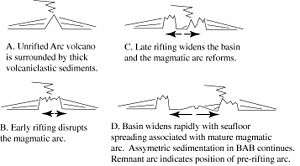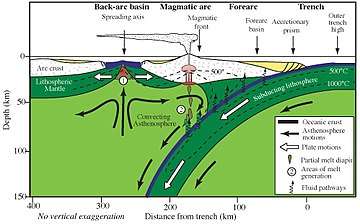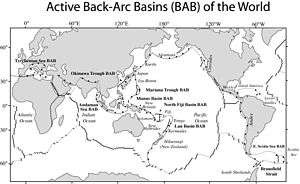Back-arc basin
Back-arc basins are geologic basins, submarine features associated with island arcs and subduction zones. They are found at some convergent plate boundaries, presently concentrated in the western Pacific Ocean. Most of them result from tensional forces caused by oceanic trench rollback (the oceanic trench is wandering in the seafloor direction) and the collapse of the edge of the continent. The arc crust is under extension or rifting as a result of the sinking of the subducting slab. Back-arc basins were initially a surprising result for plate tectonics theorists, who expected convergent boundaries to be zones of compression, rather than major extension. However, they are now recognized as consistent with this model in explaining how the interior of Earth loses heat.


Characteristics
Back-arc basins are typically very long (several hundreds to thousands of kilometers) and relatively narrow (a few hundred kilometers). The restricted width of back-arc basins is probably because magmatic activity depends on water and induced mantle convection and these are both concentrated near the subduction zone. Spreading rates vary from very slow spreading (Mariana Trough), a few centimeters per year, to very fast (Lau Basin), 15 cm/year. These ridges erupt basalts that are similar to those erupted from the mid-ocean ridges; the main difference is that back-arc basin basalts are often very rich in magmatic water (typically 1-1.5 weight % H2O), whereas mid-ocean ridge basalt magmas are very dry (typically <0.3 weight % H2O). The high water contents of back-arc basin basalt magmas is derived from water carried down the subduction zone and released into the overlying mantle wedge. Additional source of water could be the eclogitization of amphiboles and micas in the subducting slab. Similar to mid-ocean ridges, back-arc basins have hydrothermal vents and associated chemosynthetic communities.
Seafloor spreading in back-arc basins
Evidence of this spreading came from cores of the basin floor. The thickness of sediment that collected in basin decreased toward the center of the basin. The idea that thickness and age of sediment on the sea floor is related to the age of the oceanic crust was proposed by Harry Hess.[1] Magnetic anomalies (see Vine–Matthews–Morley hypothesis) of the crust formed in back-arc basins deviated in form from the crust formed at mid-ocean ridges.[2] In many areas the anomalies do not appear parallel. The profiles of the magnetic anomalies in the basin do not show symmetry or a central anomaly as a traditional ocean basin does.[2]
This has prompted some to characterize the spreading in back-arc basins to be more diffused and less uniform than at mid-ocean ridges.[3] The idea that back-arc basin spreading is inherently different that mid-ocean ridge spreading has been debated through the years.[3] Another argument put forward is that the process of seafloor spreading is the same but the movement of seafloor spreading centers in the basin causes the asymmetry in the magnetic anomalies.[3] This can be seen in the Lau back-arc basin.[3] Though the magnetic anomalies are more complex to decipher the rocks sampled from back-arc basin spreading centers do not differ very much from those at mid-ocean ridges.[4] The volcanic rocks of the nearby island arc do differ from those in the basin.[4]

Asymmetry in seafloor spreading
Back-arc basins are different from normal mid-ocean ridges because they are characterized by asymmetric seafloor spreading, but this is quite variable even within single basins. For example, in the central Mariana Trough current spreading rates are 2–3 times greater on the western flank[5] whereas at the southern end of the Mariana Trough the position of the spreading center adjacent to the volcanic front suggests that overall crustal accretion has been nearly 100% asymmetric there.[6] This situation is mirrored to the north where a large spreading asymmetry is also developed.[7] Other back-arc basins such as the Lau Basin have undergone large rift jumps and propagation events that have transferred spreading centers from arc-distal to more arc-proximal positions [8] although recent spreading rates appear to be relatively symmetric with perhaps small rift jumps.[9] The cause of asymmetric spreading in back-arc basins remains poorly understood. General ideas invoke asymmetries relative to the spreading axis in arc melt generation processes and heat flow, hydration gradients with distance from the slab, mantle wedge effects, and evolution from rifting to spreading.[10][11][12]
Formation and Tectonics
The extension of the crust behind volcanic arcs is believed to be caused by processes in association with subduction.[13] As the subducting plate descends into the asthenosphere it is heated up causing the volcanism at the island arcs. Another result of this heating is a convection cell is formed[13] (See figure 1). The rising magma and heat in the convection cell cause a rift to form. This rift drives the island arc toward the subduction zone and the rest of the plate away from the subduction zone.[13] This process is also known as trench rollback (also, hinge rollback). This is the backward motion of the subduction zone relative to the motion of the plate which is being subducted. As the subduction zone and its associated trench pull backward, the overriding plate is stretched, thinning the crust which is manifest in the back-arc basin. Therefore, back-arc basins form when the overriding plate is under extension. In some cases, extension is triggered by the entrance of a buoyant feature in the subduction zone, which locally slows down subduction and induce the subducting plate to rotate adjacent to it. This rotation is associated with trench retreat and overriding plate extension.[9]
For back-arc extension to form, a subduction zone is required, but not all subduction zones have a back-arc extension feature.[14] Back-arc basins are found in areas where the subducting plate of oceanic crust is very old.[14] The age need to establish back-arc spreading is oceanic lithosphere that is 55 million years old or older.[12][14] This includes areas like the western pacific where multiple back-arc spreading centers are located.[14] The dip angle of the subducting slab is shown to be greater than 30° in areas of back-arc spreading. This is most likely due to the age of the slab. As oceanic crust gets older it becomes denser resulting in a steeper angle of descent.[14]
The thinning of the overriding plate at the back-arc (i.e., back-arc rifting) can lead to the formation of new oceanic crust (i.e., back-arc spreading). As the lithosphere stretches, the asthenospheric mantle below rises to shallow depths and partially melts due to adiabatic decompression melting. As this melt nears the surface spreading begins.
Sedimentation
Sedimentation is strongly asymmetric, with most of the sediment supplied from the active magmatic arc which regresses in step with the rollback of the trench. From cores collected during the Deep Sea Drilling Project (DSDP) nine sediment types were found in the back-arc basins of the western Pacific.[15] Debris flows of thick to medium bedded massive conglomerates account for 1.2% of sediments collected by the Deep Sea Drilling Project (DSDP).[15] The average size of the sediments in the conglomerates are pebbles sized, but can range from granules to cobbles.[15] Most of the material in these debris flows is volcanic in origin.[15] Accessory materials include limestone fragments, chert, shallow water fossils and sandstone clasts.[15]
Submarine Fan systems of interbedded turbidite sandstone and mudstone made up 20% of the total thickness of sediment recovered by the Deep Sea Drilling Project (DSDP).[15] The fans can be divided into two sub-systems based on the differences in lithology, texture, sedimentary structures, and bedding style.[15] These systems are inner and midfan subsystem and the outer fan subsystem.[15] The inner and midfan system contains interbedded thin to medium bedded sandstones and mudstones.[15] Structures that are found in these sandstones include load clasts, micro-faults, slump folds, convolute laminations, dewatering structures, graded bedding, and gradational tops of sandstone beds.[15] Partial Bouma sequences can be found within the subsystem.[15] The Outer Fan subsystem generally consists of finer sediments when compared to the inner and midfan system.[15] Well sorted volcanoclastic sandstones, siltstones and mudstones are found in this system.[15] Sedimentary structures found in this system include parallel laminae, micro-cross laminae, and graded bedding.[15] Partial Bouma sequences can be identified in this subsystem[15].
Pelagic Clays containing iron-manganese micronodules, quartz, plagioclase, orthoclase, magnetite, volcanic glass, montmorillonite, illite, smec- tite, foraminiferal remains, diatoms, and sponge spicules made up the uppermost stratigraphic section at each site it was found at. This sediment type consisted of 4.2 percent of the total thickness of sediment recovered by the Deep Sea Drilling Project (DSDP).[15]
Biogenic pelagic silica sediments consist of radiolarian, diatomaceous, silicoflagellate oozes, and chert.[15] It makes up 4.3% of the sediment thickness recovered.[15] Biogenic pelagic carbonates is the most common sediment type recovered from the back-arc basins of the western Pacific.[15] This sediment type made up 23.8% of the total thickness of sediment recovered by the Deep Sea Drilling Project (DSDP).[15] The pelagic carbonates consist of ooze, chalk, and limestone.[15] Nanofossils and foraminifera make up the majority of the sediment.[15] Resedimented carbonates made up 9.5% of the total thickness of sediment recovered by the Deep Sea Drilling Project (DSDP).[15] This sediment type had the same composition as the biogenic pelagic carbonated, but it had been reworked with well-developed sedimentary structures.[15] Pyroclastics consisting of volcanic ash, tuff and a host of other constituents including nanofossils, pyrite, quartz, plant debris, and glass made up 9.5% of the sediment recovered.[15] These volcanic sediments were source form the regional tectonic controlled volcanism and the nearby island arc sources.[15]

Location
Active back-arc basins are found in the Marianas, Tonga-Kermadec, S. Scotia, Manus, N. Fiji, and Tyrrhenian Sea regions, but most are found in the Western Pacific. Not all subduction zones have back-arc basins, some like the central Andes are associated with rear-arc compression. In addition, there are a number of extinct or fossil back-arc basins, such as the Parece Vela-Shikoku Basin, Sea of Japan, and Kurile Basin. Compressional back-arc basins are found, for example, in the Pyrenees and the Swiss Alps.[16]
The Black Sea formed from two separate back-arc basins.
History of thought
With the development of plate tectonic theory, geologists thought that convergent plate margins were zones of compression, thus zones of strong extension above subduction zones (back-arc basins) were not expected. The hypothesis that some convergent plate margins were actively spreading was developed by Dan Karig (1970) while a graduate student at the Scripps Institution of Oceanography.[17] This was the result of several marine geologic expeditions to the western Pacific.
See also
Notes
- Hess, Henry H (1962). "History of Ocean Basins". Petrological Studies: A Volume to Honor A .F. Buddington: 599–620.
- Karig, Daniel (1970). "Ridges and basins of the Tonga-Kermadec island arc system". Journal of Geophysical Research. 75 (2): 239–254. Bibcode:1970JGR....75..239K. doi:10.1029/JB075i002p00239.
- Taylor, B; Zellmer, K; Martinez, F; Goodliffe, A (1996). "Sea-floor spreading in the Lau back-arc basin". Earth and Planetary Science Letters. 43: 163–200.
- Gill, J.B. (1976). "Composition and age of Lau Basin and Ridge volcanic rocks: Implications for evolution of an interarc basin and remnant arc". GSA Bulletin. 87 (10): 1384–1395. Bibcode:1976GSAB...87.1384G. doi:10.1130/0016-7606(1976)87<1384:CAAOLB>2.0.CO;2.
- Deschamps, A.; Fujiwara, T. (2003). "Asymmetric accretion along the slow-spreading Mariana Ridge". Geochem. Geophys. Geosyst. 4 (10): 8622. Bibcode:2003GGG.....4.8622D. doi:10.1029/2003GC000537.
- Martinez, F.; Fryer, P.; Becker, N. (2000). "Geophysical Characteristics of the Southern Mariana Trough, 11N-13N". J. Geophys. Res. 105 (B7): 16591–16607. Bibcode:2000JGR...10516591M. doi:10.1029/2000JB900117.
- Yamazaki, T.; Seama, N.; Okino, K.; Kitada, K.; Joshima, M.; Oda, H.; Naka, J. (2003). "Spreading process of the northern Mariana Trough: Rifting-spreading transition at 22 N". Geochem. Geophys. Geosyst. 4 (9): 1075. Bibcode:2003GGG.....4....1Y. doi:10.1029/2002GC000492.
- Parson, L.M.; Pearce, J.A.; Murton, B.J.; Hodkinson, R.A.; RRS Charles Darwin Scientific Party (1990). "Role of ridge jumps and ridge propagation in the tectonic evolution of the Lau back-arc basin, southwest Pacific". Geology. 18 (5): 470–473. Bibcode:1990Geo....18..470P. doi:10.1130/0091-7613(1990)018<0470:RORJAR>2.3.CO;2.
- Zellmer, K.E.; Taylor, B. (2001). "A three-plate kinematic model for Lau Basin opening". Geochem. Geophys. Geosyst. 2 (5): 1020. Bibcode:2001GGG.....2.1020Z. doi:10.1029/2000GC000106. 2000GC000106.
- Barker, P.F.; Hill, I.A. (1980). "Asymmetric spreading in back-arc basins". Nature. 285 (5767): 652–654. Bibcode:1980Natur.285..652B. doi:10.1038/285652a0.
- Martinez, F.; Fryer, P.; Baker, N.A.; Yamazaki, T. (1995). "Evolution of backarc rifting: Mariana Trough, 20-24N". J. Geophys. Res. 100 (B3): 3807–3827. Bibcode:1995JGR...100.3807M. doi:10.1029/94JB02466.
- Molnar, P.; Atwater, T. (1978). "Interarc spreading and Cordilleran tectonics as alternates related to the age of subducted oceanic lithosphere". Earth Planet. Sci. Lett. 41 (3): 330–340. Bibcode:1978E&PSL..41..330M. doi:10.1016/0012-821X(78)90187-5.
- Forsyth, D; Uyeda, S (1975). "On the Relative Importance of the Driving Forces of Plate Motion". Geophysical Journal International. 7 (4): 163–200. doi:10.1111/j.1365-246X.1975.tb00631.x.
- Sdrolias, M; Muller, R.D. (2006). "Controls on back-arc basin formations". Geochemistry, Geophysics, Geosystems. 7 (4): Q04016. Bibcode:2006GGG.....7.4016S. doi:10.1029/2005GC001090.
- Klein, G.D. (1985). "The Control of Depositional Depth, Tectonic Uplift, and Volcanism on Sedimentation Processes in the Back-Arc Basins of the Western Pacific Ocean". Journal of Geology. 93 (1): 1–25. Bibcode:1985JG.....93....1D. doi:10.1086/628916.
- Munteanu, I. et al. (2011). "Kinematics of back-arc inversion of the Western Black Sea Basin" in Tectonics 30(5), DOI: 10.1029/2011tc002865
- Karig, Daniel E. (1970). "Ridges and basins of the Tonga-Kermadec island arc system". Journal of Geophysical Research. 75 (2): 239–254. Bibcode:1970JGR....75..239K. doi:10.1029/JB075i002p00239.
References
- Uyeda S (1984). "Subduction zones; their diversity, mechanism and human impact". GeoJournal. 8 (1): 381–406. doi:10.1007/BF00185938.
- Taylor, Brian. (1995). Backarc Basins: Tectonics and Magmatism. New York: Plenum Press. ISBN 9780306449376; OCLC 32464941
- Deschamps, A.; Fujiwara, T. (2003). "Asymmetric accretion along the slow-spreading Mariana Ridge". Geochem. Geophys. Geosyst. 4 (10): 8622. Bibcode:2003GGG.....4.8622D. doi:10.1029/2003GC000537.
- Martinez, F.; Fryer, P.; Becker, N. (2000). "Geophysical Characteristics of the Southern Mariana Trough, 11N-13N". J. Geophys. Res. 105: 16591–16607. Bibcode:2000JGR...10516591M. doi:10.1029/2000JB900117.
- Yamazaki, T.; Seama, N.; Okino, K.; Kitada, K.; Joshima, M.; Oda, H.; Naka, J. (2003). "Spreading process of the northern Mariana Trough: Rifting-spreading transition at 22 N". Geochem. Geophys. Geosyst. 4 (9): 1075. Bibcode:2003GGG.....4....1Y. doi:10.1029/2002GC000492.
- Parson, L.M.; Pearce, J.A.; Murton, B.J.; Hodkinson, R.A.; RRS Charles Darwin Scientific Party (1990). "Role of ridge jumps and ridge propagation in the tectonic evolution of the Lau back-arc basin, southwest Pacific". Geology. 18 (5): 470–473. Bibcode:1990Geo....18..470P. doi:10.1130/0091-7613(1990)018<0470:RORJAR>2.3.CO;2.
- Zellmer, K.E.; Taylor, B. (2001). "A three-plate kinematic model for Lau Basin opening". Geochem. Geophys. Geosyst. 2 (5): 1020. Bibcode:2001GGG.....2.1020Z. doi:10.1029/2000GC000106. 2000GC000106.
- Barker, P.F.; Hill, I.A. (1980). "Asymmetric spreading in back-arc basins". Nature. 285 (5767): 652–654. Bibcode:1980Natur.285..652B. doi:10.1038/285652a0.
- Martinez, F.; Fryer, P.; Baker, N.A.; Yamazaki, T. (1995). "Evolution of backarc rifting: Mariana Trough, 20-24N". J. Geophys. Res. 100: 3807–3827. Bibcode:1995JGR...100.3807M. doi:10.1029/94JB02466.
- Molnar, P.; Atwater, T. (1978). "Interarc spreading and Cordilleran tectonics as alternates related to the age of subducted oceanic lithosphere". Earth Planet. Sci. Lett. 41 (3): 330–340. Bibcode:1978E&PSL..41..330M. doi:10.1016/0012-821X(78)90187-5.
- Wallace, Laura M.; Ellis, Susan; Mann, Paul (2009). "Collisional model for rapid fore-arc block rotations, arc curvature, and episodic back-arc rifting in subduction settings". Geochemistry, Geophysics, Geosystems. 10 (5): n/a–n/a. doi:10.1029/2008gc002220. ISSN 1525-2027
- Karig, Daniel E. (1970). "Ridges and basins of the Tonga-Kermadec island arc system". Journal of Geophysical Research. 75 (2): 239–254. Bibcode:1970JGR....75..239K. doi:10.1029/JB075i002p00239.
- Hess, Henry H. (1962). “History of Ocean Basins”. Petrological Studies: A volume to honor A .F. Buddington. 599-620
- Taylor, B.; Zellmer, K.; Martinez, F.; Goodliffe, A. (1996). “Sea-floor spreading in the Lau back-arc basin”. Earth and Planetary Science Letters. 144:35-40
- Forsyth, D.; Uyeda, S. (1975) “On the Relative Importance of the Driving Forces of Plate Motion*”. Geophysical Journal International. 43: 163-200
- Sdrolias, M.; Muller, R.D. (2006) “Controls on back-arc basin formations”. Geochemistry, Geophysics, Geosystems.7(4): 1-40 doi:10.1029/2005GC001090
- Gill, J.B. (1976) “Composition and age of Lau Basin and Ridge volcanic rocks: Implications for evolution of an interarc basin and remnant arc”. GSA Bulletin. 87(10):1384-1395
- Klein, G.D. (1985) “ The Control of Depositional Depth, Tectonic Uplift, and Volcanism on Sedimentation Processes in the Back-Arc Basins of the Western Pacific Ocean”. Journal of Geology. 93(1): 1-25
External links
- Animation of subduction, trench rollback and back-arc basin expansion in EGU GIFT2017: Shaping the Mediterranean from the inside out, YouTube.

